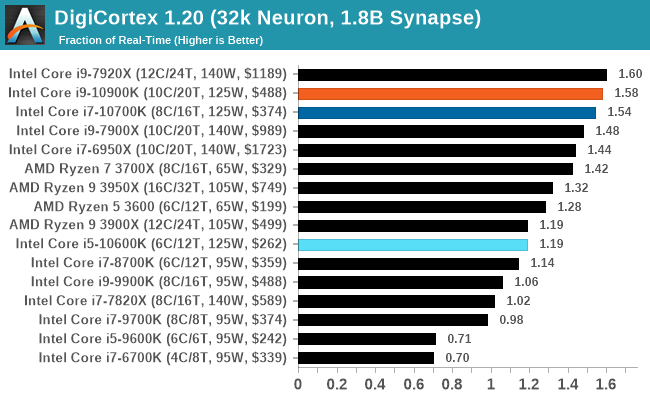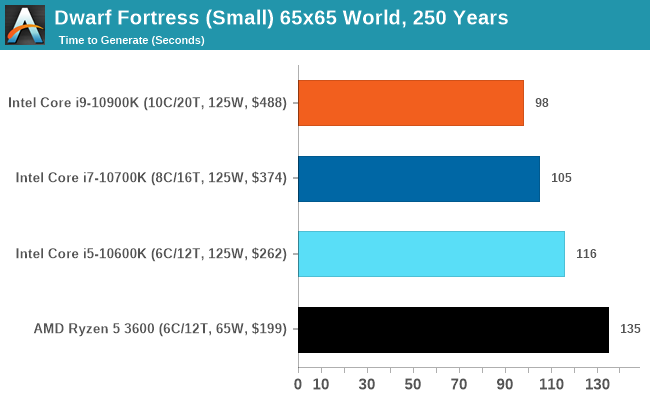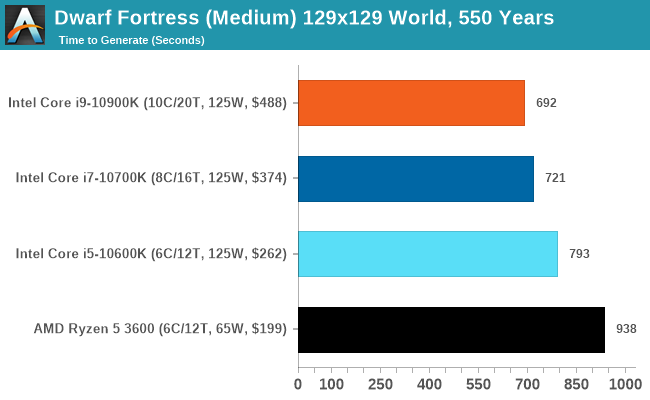The Intel Comet Lake Core i9-10900K, i7-10700K, i5-10600K CPU Review: Skylake We Go Again
by Dr. Ian Cutress on May 20, 2020 9:00 AM EST- Posted in
- CPUs
- Intel
- Skylake
- 14nm
- Z490
- 10th Gen Core
- Comet Lake
CPU Performance: Simulation Tests
A number of our benchmarks fall into the category of simulations, whereby we are either trying to emulate the real world or re-create systems with systems. In this set of tests, we have a variety including molecular modelling, non-x86 video game console emulation, a simulation of the equivalent of a slug brain with neurons and synapses firing, and finally a popular video game that simulates the growth of a fictional land including historical events and important characters within that world.
NAMD ApoA1
One frequent request over the years has been for some form of molecular dynamics simulation. Molecular dynamics forms the basis of a lot of computational biology and chemistry when modeling specific molecules, enabling researchers to find low energy configurations or potential active binding sites, especially when looking at larger proteins. We’re using the NAMD software here, or Nanoscale Molecular Dynamics, often cited for its parallel efficiency. Unfortunately the version we’re using is limited to 64 threads on Windows, but we can still use it to analyze our processors. We’re simulating the ApoA1 protein for 10 minutes, and reporting back the ‘nanoseconds per day’ that our processor can simulate. Molecular dynamics is so complex that yes, you can spend a day simply calculating a nanosecond of molecular movement.
This is one of our new tests, so we will be filling in more data as we start regression testing for older CPUs.

Dolphin 5.0: Console Emulation
One of the popular requested tests in our suite is to do with console emulation. Being able to pick up a game from an older system and run it as expected depends on the overhead of the emulator: it takes a significantly more powerful x86 system to be able to accurately emulate an older non-x86 console, especially if code for that console was made to abuse certain physical bugs in the hardware.
For our test, we use the popular Dolphin emulation software, and run a compute project through it to determine how close to a standard console system our processors can emulate. In this test, a Nintendo Wii would take around 1050 seconds.
The latest version of Dolphin can be downloaded from https://dolphin-emu.org/

DigiCortex 1.20: Sea Slug Brain Simulation
This benchmark was originally designed for simulation and visualization of neuron and synapse activity, as is commonly found in the brain. The software comes with a variety of benchmark modes, and we take the small benchmark which runs a 32k neuron / 1.8B synapse simulation, equivalent to a Sea Slug.
Example of a 2.1B neuron simulation
We report the results as the ability to simulate the data as a fraction of real-time, so anything above a ‘one’ is suitable for real-time work. Out of the two modes, a ‘non-firing’ mode which is DRAM heavy and a ‘firing’ mode which has CPU work, we choose the latter. Despite this, the benchmark is still affected by DRAM speed a fair amount.
DigiCortex can be downloaded from http://www.digicortex.net/

The additional bandwidth of the HEDT platforms put them higher up the chart here - Digicortex always ends up as an odd mix of bottlenecks mostly around memory, but it can be localized internal bandwidth limited as well.
Dwarf Fortress
Another long standing request for our benchmark suite has been Dwarf Fortress, a popular management/roguelike indie video game, first launched in 2006. Emulating the ASCII interfaces of old, this title is a rather complex beast, which can generate environments subject to millennia of rule, famous faces, peasants, and key historical figures and events. The further you get into the game, depending on the size of the world, the slower it becomes.
DFMark is a benchmark built by vorsgren on the Bay12Forums that gives two different modes built on DFHack: world generation and embark. These tests can be configured, but range anywhere from 3 minutes to several hours. I’ve barely scratched the surface here, but after analyzing the test, we ended up going for three different world generation sizes.
This is another of our new tests.














220 Comments
View All Comments
catavalon21 - Wednesday, May 20, 2020 - link
+1Lord of the Bored - Friday, May 22, 2020 - link
The nostalgia is strong these days.Bidz - Wednesday, May 20, 2020 - link
So... where is the temperature chart? Given the power usage and the tier level of the product I would say many users want to know how practical it is to use.LawRecords - Wednesday, May 20, 2020 - link
Agreed. Its odd that thermals are missing given the high power draw.shabby - Wednesday, May 20, 2020 - link
I'd imagine it would be pegged at 90c since the cpu is constantly clocking itself as high as it can.DannyH246 - Wednesday, May 20, 2020 - link
Its not odd at at all. Its to make Intel look better we all know this.shady28 - Wednesday, May 20, 2020 - link
LTT has a video on thermals. The thermals for the gen 10 are better than gen 9, despite the higher clocks and core counts. Intel redesigned the conductive layer between the die and the lid. It worked.Spunjji - Tuesday, May 26, 2020 - link
Seriously? The thermals are better despite the higher power draw?I'm guessing this is a case of being able to get the heat out more easily *if you have a cooling system capable of subsequently dealing with the heat being pulled out*. That would make sense given the changes involved, but it involves the assumption that people are prepared to go from 280mm+ radiators.
mrvco - Wednesday, May 20, 2020 - link
I get that this is a CPU review and not a GPU or system review, but it would be helpful to also include gaming resolutions w/ quality settings that people actually use for gaming rather just benchmarking... especially when building a gaming system and making decisions on how to allocate budget between CPU (+p/s +cooling) and GPU.TheUnhandledException - Wednesday, May 20, 2020 - link
I agree. Yes the result will show nearly identical performance from a 10900 down to an Ryzen 3600 but that is kinda the point. You don't really need an ultra high end CPU for gaming at high resolution. Even if it was just one game it would be nice to see how CPU performance scales at 1080p, 1080p high quality, 1440p, and 4K.